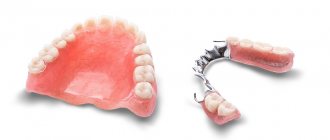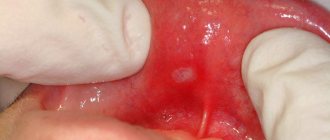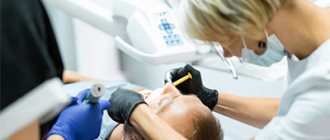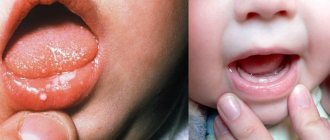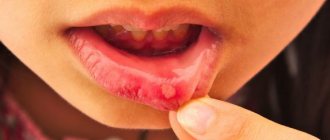Causes of stomatitis
In children, as in adults, stomatitis can be caused by viruses, fungi, bacteria, allergies and injuries. About six months after birth, the child loses the immunity received from the mother, the protective power of the immune system changes, and the child’s body becomes more susceptible to infections. The oral mucosa in children is more delicate and easier to injure; children also more often “bite” their cheeks after dental treatment due to a temporary loss of sensitivity after anesthesia, which causes traumatic stomatitis.
Children are not always motivated to brush their teeth, so poor hygiene can also cause stomatitis.
With the following diseases, stomatitis is observed in children much more often: chronic tonsillitis, diabetes mellitus, heart defects, chronic hepatitis.
Aphthous stomatitis: treatment, drugs
Aphthous stomatitis in adults is the same as canker sores in children - the treatment is the same, and the treatment strategy described below is suitable for patients of any age. As for the medications listed later in the article, some of them do have age restrictions, which we will also indicate.
Due to the fact that it is usually impossible to clearly identify the specific cause of aphthous stomatitis in a particular patient, treatment will be multifocal, i.e. drugs of several groups are used simultaneously. The choice of treatment strategy and medications will depend on the following 3 factors:
1) on the severity of symptoms, 2) on the frequency of relapses, 3) on identified predisposing factors.
Treatment at the first stage should be aimed at reducing pain and inflammation in the area of ulcers, and at the second and third stages - at speedy epithelization of ulcers and preventing their occurrence in the future. To facilitate the choice of the best treatment option, all patients can be divided into 3 types (according to the criteria - severity of the disease and frequency of relapses).
- Type A - in patients of this type, aphthous stomatitis occurs no more than several times during the year and is characterized by slight pain.
First of all, in such patients it is necessary to identify local predisposing factors and eliminate them (for example, overhanging edges of fillings or hygiene products with sodium lauryl sulfate). It is important to ask the patient about eating habits to evaluate a possible relationship between stomatitis outbreaks and certain foods. The patient is advised to avoid solid foods (eg, crackers, toast), all types of nuts, chocolate, eggs, acidic drinks or foods - fruit or citrus juices, tomatoes, pineapples, salty foods. You should avoid eating spicy foods, any spices, including pepper and curry, as well as alcoholic and carbonated drinks. In type A patients, local symptomatic therapy is mainly used, which includes antiseptic rinses and gel applications for pain and inflammation + antihistamines.
- Type B - in such patients, aphthous stomatitis develops almost monthly, and the ulcers are so painful that they force the patient to change habits (for example, brushing teeth less often due to severe pain). It remains important to identify local and general predisposing factors and, if possible, eliminate them. It is very important to teach patients of this type to feel the first signs of the imminent appearance of ulcers - burning, itching or swelling of the mucous membrane, in order to provide early local treatment even before the formation of the ulcers themselves.
- Type C - in patients of this type, ulcers are very painful, appear so often that while one lesion is healing, the next one appears almost immediately. This group also includes patients in whom local treatment in the oral cavity is completely ineffective, and improvement in their condition occurs only after the use of systemic therapy (we will also discuss such therapy below).
Classification of HRAS (chronic recurrent aphthous stomatitis)
| CLASSIFICATION | A COMMENT | ||
| classification: | According to the degree of damage to the mucous membrane: | a comment: | 1) Superficial (catarrhal, fibrinous) 2) Deep (ulcerative, necrotic) |
| classification: | According to the clinical course: | a comment: | 1) acute 2) chronic |
All types of stomatitis occur in children, but the most common are: herpetic, candidal and traumatic stomatitis.
Acute herpetic stomatitis
It occurs most often, and mainly affects children from 10 months to 3 years.3 The appearance of rashes is preceded by inflammation of the lymph nodes.
With a mild form
In acute herpetic stomatitis, the temperature rises to 37-37.5°C, the general condition is satisfactory, slight swelling and redness may occur on the gums, then up to six blisters appear, which burst with the formation of painful aphthae surrounded by a red rim.
Afta is a round-shaped erosion. Aphthae may merge together. The rash appears once, and after 1-2 days the erosion gradually heals.
Moderate form
Acute herpetic stomatitis is characterized by deterioration of the child’s well-being, weakness, and headache. The child is capricious, has no appetite, the lymph nodes are enlarged and painful, the temperature rises to 38-39°C, the symptoms resemble ARVI. The oral mucosa is swollen, reddened, rashes appear (bubbles, then erosions) of 10-15 pieces, and often there are rashes on the face. Salivation increases, and gingivitis appears (inflammation of the gums, accompanied by bleeding). The rash may appear several times, i.e. after the old ones heal, new ones appear. Healing of erosions takes up to 4-5 days. Bleeding gums and swollen lymph nodes persist for some time after the erosions have healed.
Severe form
It begins as an acute respiratory viral infection, there is pain in the muscles, joints, tachycardia and bradycardia (increased and slow heartbeat), and nosebleeds may even be observed. In this form, the temperature is high up to 40°C, gingivitis is pronounced, the mucous membrane is bright red, swollen, the child’s lips are dry, the mucous membrane of the eyes is swollen, reddened. The rashes constantly appear again, their number can reach 100. Rashes often appear around the mouth, on the eyelids, on the mucous membranes of the eyes, between the fingers, on the earlobes. Simple gingivitis turns into ulcerative (a more severe form of gum inflammation, with the formation of ulcers), salivation increases, and bad breath appears. Recovery is long and hospitalization is often required.
Local treatment of aphthous stomatitis:
Below we will talk in detail about how to treat aphthous stomatitis in children and adults. Please note that topical therapy in the oral cavity is basic, and that it gives good results only in patients of type A, and to a much lesser extent in patients of type B. For patients of types B and C, good results can only be achieved here when using systemic therapy.
1) Antiseptic rinses –
This could be Miramistin, Chlorhexidine or Hexoral. If we are talking about children, then at the age of 0 to 3 years it is optimal to use Miramistin in the form of a spray, irrigation from which is carried out 4 times a day. In children over 3 years old, it is already possible to use Hexoral aerosol - this combined drug contains the antiseptic hexetidine, as well as components with anti-inflammatory and analgesic effects (methyl salicylate, peppermint oil, anise oil, clove oil, eucalyptus oil).
The disadvantage of Miramistin is that after irrigating or rinsing the mouth with this drug, there is no indelible layer left on the oral mucosa. Those. The antiseptic included in Miramistin will be completely washed off with saliva within 10 minutes after use. At the same time, after using hexetidine (part of Hexoral), as well as chlorhexidine, an indelible layer of the drug is formed on the mucous membrane, in which clinically effective concentrations of the antiseptic will remain for approximately another 7 to 12 hours.
That is why Miramistin should be used for aphthous stomatitis 4 times a day, and Hexoral or chlorhexidine should be used only 2 times a day (the latter will still be more effective). In addition, when a child can already rinse his mouth independently without swallowing the drug, it is advisable to rinse his mouth with Miramistin for about 2 minutes, for adults - 3 minutes. At the same time, rinse your mouth with Chlorhexidine or Hexoral solution - just 1 minute 2 times a day.
Summary: in general, the drug Miramistin is worth choosing - either for children under 3 years of age, or if the patient can already rinse his mouth on his own 3-4 times a day for 2-3 minutes. The fact is that an important advantage of miramistin is that it has the property of stimulating the local immunity of the oral mucosa. But this effect will not be significant when using a spray (here you need full rinses 3-4 times a day for 2-3 minutes). In all other cases, we recommend Hexoral in the form of an aerosol for children, and in the form of a rinse solution for adults. If you need an inexpensive drug, choose Chlorhexidine.
2) Anti-inflammatory/pain-relieving gels –
The best option for adults and children is the drug Cholisal based on choline salicylate and cetalkonium chloride, which have an antiseptic, anti-inflammatory and analgesic effect. The advantage of this drug is the complete absence of age restrictions. The drug is applied to the ulcerations of the mucous membrane - using light massaging movements, using a clean index finger), i.e. you have to rub it in gently. Before applying the drug, it is advisable to dry the mucous membrane at the application site using a dry gauze swab (this will increase efficiency).
To relieve pain from ulcers in adults and children over 12 years of age, you can use the drug Kamistad, containing 2% lidocaine hydrochloride, chamomile extract and the antiseptic benzalkonium chloride. And for young children - the drug “Kamistad Baby” based on chamomile extract and polidocanol (this is a weak pain-relieving component). But in comparison with Cholisal, the effectiveness of these drugs for aphthous stomatitis will certainly be lower.
Interesting: according to the results of European and American clinical studies, the prescription drug Amlexanox (trade name Aphthasol) was recognized as the best drug for the treatment of aphthous stomatitis. This drug is available in the form of a paste for application to the surface of ulcers 4 times a day, and it has anti-inflammatory, antiallergic and immunomodulatory effects. Unfortunately, it is not sold in Russia and can only be purchased by prescription in Europe or the USA.
3) Occlusive/protective agents –
In patients with severe pain (very painful ulcers), the use of an anti-inflammatory/analgesic gel alone may not be enough. And for such patients we can recommend the use of bismuth-based drugs (for example, it can be bismuth subsalicylate or bismuth tripotassium dicitrate). Such drugs are usually used in the treatment of gastric and duodenal ulcers to reduce pain.
The point of using these drugs is that when applied to the surface of ulcers, they form an insoluble protective film that protects the surface of the ulcer from irritants (this significantly reduces pain). For example, this could be the drug “De-nol”, or its less expensive analogues. In adults, these drugs are used as chewable tablets, and for young children - in the form of a suspension, which must be applied with a pipette directly to the lesions of the mucous membrane. You can make the suspension yourself - you need to crush the tablet into powder by adding a small amount of water.
A similar product is the protective gel “Gerpenox” from Rox. This medication contains hydroxyethylcellulose as well as Chelate Organic Germanium Guanine Complex. These components also create a protective film on the surface of the ulcers, which protects them from irritants, thereby reducing pain. Well, there is an additional effect - it will speed up the healing of the damaged mucous membrane by about 1 day.
4) Epithelizing agents –
As we said above, at the 1st stage of treatment of aphthous stomatitis, it is very important to use antiseptic rinses, special gels for pain and inflammation, bismuth-based occlusive agents + oral antihistamines. But when the acute symptoms have passed, it is very important to accelerate the epithelization of the surface of the ulcers. For these purposes, the drug Solcoseryl in gel form can be used, as well as sea buckthorn oil, rosehip oil, carotoline, vinylin, and oil solutions of vitamins A and E.
As for Solcoseryl gel, it not only accelerates the epithelization of the surface of ulcers and erosions, but also has a sufficient analgesic effect (the drug is applied to the surface of ulcers 2-3 times a day). Read the instructions for use below. Once again, we draw your attention to the fact that this drug is not intended for use in the acute phase of ulcer formation, and therefore its use usually begins only 5-6 days after their formation.
→ Use of the drug Solcoseryl
5) Local application of laser –
Clinical studies have found that the use of diode laser (940 nm wavelength) as well as Nd:YAG laser provides immediate pain relief and faster healing, and is well tolerated by patients. Most patients note that ulcerative lesions heal much faster after laser treatment. For example, laser-treated ulcers measuring 0.5 cm in diameter are completely epithelized in just 3-4 days (instead of 7-10 days).
In addition, patients noted that relapses of aphthous stomatitis after laser treatment occur much less frequently. Below you can see photos of foci of aphthous stomatitis on the tongue and lip - BEFORE laser treatment, and also 3 days after their treatment with a 940-nm diode laser. An alternative to laser can be the use of ultraviolet irradiation of the oral cavity (in comparison with lasers, this method is not as effective, but it can also speed up the healing of ulcers).
Laser treatment of aphthous stomatitis (before and after photos) –
6) Local application of glucocorticoids –
If aphthous stomatitis develops against the background of diagnosed immune diseases, then treatment can be carried out with glucocorticoids. Treatment with glucocorticoids is also indicated if the patient does not respond to treatment with traditional local remedies (see above). The purpose of their use is to eliminate severe pain and inflammation, which will allow the patient to eat, speak normally, and carry out normal oral hygiene (glucocorticoids also reduce the healing time of ulcers).
Most often, “triamcinolone acetonide”, “fluocinolone acetonide” or “clobetasol propionate” are used for this (the choice depends on the severity of the lesions). When ulcerative lesions are localized, in this case these drugs are used in the form of gels, but if the lesions are very numerous, solutions for mouth rinsing will have to be prepared (using solutions of these drugs in ampoules). Another option for local use of glucocorticoids is a single local injection of triamcinolone solution at the base of each ulcer.
Enteroviral vesicular stomatitis (arm - leg - mouth)
Caused by enteroviruses. It also occurs in adults, but in 95.7% of cases children are affected.6 It is characterized by seasonal occurrence (summer - autumn) and group incidence.4 It is observed mainly in children under 10 years of age. Vesicular stomatitis is contagious, so it is recommended to use separate utensils and hygiene products. Characteristics for this disease: temperature 37.5-38, weakness, headache, muscle pain, rash on the palms, soles, as well as blisters on the hard palate and pharynx, which then turn into erosions that are almost not painful.
Acute pseudomembranous candidal stomatitis (thrush)
Acute pseudomembranous candidal stomatitis (thrush) occurs:
- Light shape
- Medium-heavy forms
- Severe form
The main symptom of the disease is a white or yellow coating.
With a mild form
The plaque is located in islands, most often on the tongue and cheeks. Children are restless, sleep poorly, and suck the breast sluggishly. Older children may complain of a burning sensation. The plaque is easily removed; underneath there is a bright red mucous membrane. The disease lasts no longer than 7 days.5
Moderate form
The plaque is located on the cheeks, tongue, hard palate, and mucous membranes of the lips. Under the plaque, erosions form, which sometimes bleed. The plaque is more difficult to remove. Lymph nodes are sometimes enlarged and painful. The duration of the disease is 10-15 days, there are relapses.
Moderate form
The plaque is dirty gray, almost cannot be removed, and is located on the tongue, cheeks, soft palate, tonsils, pharynx, and mucous membranes of the lips. Cheilitis appears in the corners of the mouth - inflammation of the lips. The oral mucosa is dry and inflamed. The child’s health is impaired, the child refuses to eat, and the temperature rises. Lesions in the genital area, neck folds, and between the fingers are also common. The disease is long-term, with frequent relapses.
Bacterial stomatitis in children
Necrotizing ulcerative stomatitis is more common in weakened children and is caused by fusobacteria and spirochetes. May be a sign of periodontal disease (progressive destruction of periodontal tissue). It is characterized by the appearance of painful ulcers, weakness, gingivitis (inflammation of the gums), enlarged and painful lymph nodes, difficulty eating, speaking, and bad breath.
Often, erosions in traumatic stomatitis can become infected through dirty hands, toys and other objects, then bacterial stomatitis develops, so it is important to pay attention to antiseptic treatment.
Traumatic stomatitis in children
A specific form of traumatic stomatitis in children is Bednar's aphthae . This is a traumatic erosion of the oral mucosa. In children, unlike adults, the mucosal epithelium consists not of four layers, but of two, so it is easily injured. The cause may be early teething, a rough nipple from the mother, or a long nipple on the bottle. Erosion is most often located in the middle of the palate or opposite the cutting edge of the teeth. The child begins to refuse food, cries, and sleeps poorly.
Traumatic stomatitis also occurs in children when wearing braces. Erosions have uneven edges, are painful, and are usually located on the mucous membrane of the cheeks and lips, less often on the tongue.
Aphthous stomatitis: symptoms
If you suspect you have aphthous stomatitis, the symptoms are quite similar. A day or two before the onset of ulcers, patients usually notice a slight burning sensation in some areas of the oral mucosa. A little later, one or 2-3 clearly defined ulcers (aphthae) appear, covered with a necrotic coating of a gray or yellowish tint. The ulcers are round in shape and their diameter is usually no more than 1 cm, and along the perimeter they are surrounded by an inflammatory red halo.
Ulcers of this size usually heal within 10 to 14 days without scarring. However, in 10-15% of patients, the diameter of the ulcers may exceed 1 cm, and sometimes they can even reach 2-3 cm in diameter. Ulcers of this size are usually deeper than ulcers smaller than 1 cm (which may cause the ulcer border to appear raised). Healing of such ulcers usually lasts up to 6 weeks, and most often with the formation of scar tissue.
Important: the typical localization of ulcers is on the mucous membrane of the cheeks and the inside of the lips, on the soft palate (Fig. 7-8), tonsils, as well as the lower and lateral surfaces of the tongue. This localization is due to the fact that ulcers in aphthous stomatitis occur primarily on “non-keratinized” areas of the oral mucosa, i.e. where keratinization of the mucosal epithelium does not occur.
Less commonly, ulcers can occur on the keratinized mucous membrane (hard palate, dorsum of the tongue, tightly attached alveolar gum around the teeth) - this may be a signal of autoimmune diseases or HIV infection. In contrast to aphthous stomatitis, keratinized gums are affected precisely in herpetic stomatitis, which can also be a distinguishing feature of these two main forms of stomatitis from each other.
Foci of aphthous stomatitis on the soft palate (photo) –
→ Symptoms of herpetic stomatitis
Drug-induced stomatitis
Occurs when there is an allergy to a drug. Often, allergies can occur to antibacterial, antimicrobial drugs, vaccines, iodine. The mucous membrane is red, swollen, the lips and tongue also often swell, blisters appear, which burst, leaving erosion. The gums are inflamed and bleed when touched. General manifestations are possible, such as urticaria, nausea, vomiting. In severe cases, anaphylactic shock occurs (an emergency condition manifested by decreased blood pressure, shortness of breath, fainting, suffocation), Quincke's edema (an atypical reaction of the body, manifested by rapid and severe swelling)
Both conditions are extremely dangerous and require immediate action and calling an ambulance!
Allergic stomatitis
The occurrence of allergic stomatitis can be associated with the penetration of an allergen into the body or direct contact with the oral mucosa. In the first case, allergic stomatitis will serve as a manifestation of a systemic reaction (to pollen, medications, mold, food, etc.); in the second, a local reaction to irritating factors in direct contact with the mucous membrane (toothpaste, dentures, medicinal lozenges, mouth rinses, etc.).
The development of contact allergic stomatitis is most often associated with increased sensitivity to materials used in dentistry: preparations for topical anesthesia, metal fillings, braces, orthodontic plates, crowns, acrylic or metal dentures. In acrylic dentures, allergic factors, as a rule, are residual monomers, and in rare cases, dyes.
When using metal dentures, an allergy to alloys containing chromium, nickel, gold, palladium, platinum, etc. may develop. In addition, caries, chronic tonsillitis, as well as pathogenic microorganisms and products that accumulate in the denture bed play a certain role in the pathogenesis of allergic stomatitis. their vital functions, which irritate the mucous membrane.
Risk factors
Contact allergic stomatitis is more often observed in patients suffering from chronic gastrointestinal diseases (gastritis, cholecystitis, pancreatitis, colitis, dysbacteriosis, helminthiasis, etc.), endocrine pathology (diabetes mellitus, hyperthyroidism, menopausal disorders, etc.). This is explained by the fact that organic and functional disorders in these diseases change the body’s reactivity and cause sensitization to contact allergens.
The development of severe forms of stomatitis is facilitated by other allergic diseases: drug disease, food allergies, rhinitis, urticaria, eczema, Quincke's edema, asthmatic bronchitis, bronchial asthma, etc. Allergic stomatitis does not always occur in isolation; sometimes it is included in the structure of systemic diseases - vasculitis, hemorrhagic diathesis, erythema multiforme exudative, systemic lupus erythematosus, scleroderma, Behçet's disease, Lyell's syndrome, Reiter's syndrome, Stevens-Johnson syndrome, etc.
Prevention of stomatitis in children
In children's groups, infections spread especially quickly. Therefore, if a child is infected with the herpes virus, he needs to stay at home until he recovers. Children who have been in contact with sick people should use antiviral ointments for 5 days.
If a pregnant woman has herpes or candidiasis, she should treat it before giving birth. If you have the herpes virus during the period of illness, you should use separate utensils, do not kiss children, and wear a mask.
Kindergartens and other preschool institutions must be cleaned and objects, including toys, must be treated with disinfectants.
To avoid allergic reactions, you should seek help from an allergist to identify existing allergies.
It is worth preventing a decrease in immunity; hardening works especially well in childhood. It is worth limiting your intake of fast carbohydrates, because... they create a favorable environment for the development of candidiasis. An important point is the proper nutrition of the child; regular intake of vitamins, especially vitamin C, is essential.
Tantum® Propolis
For children over 14 years of age , you can use Tantum® Propolis lozenges; they contain a lot of vitamin C, which will strengthen the immune system, and propolis has an anti-inflammatory effect, preventing the occurrence of infections.7
Find out more
Prevention of Bednar's aft is preparing the breasts for feeding, using special creams to soften the skin, prevent cracks, and it is also worth choosing the right bottle. In case of injury due to braces, you need to use orthodontic wax; here it is important to prevent the wounds from becoming infected, so it is better to treat them with antiseptic solutions and sprays.
Tantum® Verde spray will relieve pain at the site of injury and its antiseptic effect will prevent infection.8,9
Causes of aphthous stomatitis –
The leading role in the development of recurrent aphthous stomatitis is played by the immune system, namely reduced “immunological reactivity”, as well as disturbances in the system of “nonspecific protective factors”. For parents, it is not necessary to know the details, but it is important to understand that such changes in the immune system are primarily caused by - 1) the presence of foci of chronic infection in the child, for example, this could be a sore throat, chronic tonsillitis or pharyngitis, 2) diseases of the gastrointestinal tract, 3) frequent stressful situations can also play a role.
In patients with aphthous stomatitis, the following occurs: a decrease in the number and functional activity of T-lymphocytes - with a simultaneous increase in the number of B-lymphocytes, an increase in the level of serum immunoglobulins (antibodies) of the IgG class and circulating immune complexes. The result of all this is an excessive immune response to bacterial antigens. The main bacterial antigen for aphthous stomatitis is the α-hemolytic streptococcus Streptococcus sangui (absolutely all people have it, and in the normal state of the immune system it is not pathogenic).
An excessive immune response manifests itself in the development of an autoimmune reaction, which is also directed against the epithelial cells of the oral mucosa. This reaction involves both the cellular immune system (for example, neutrophils, mast cells) and humoral immunity (antibodies). As a result of the autoimmune process, foci of epithelial necrosis appear on the oral mucosa, i.e. Several ulcers form.
Additional factors –
But in addition to the main mechanism for the development of aphthous stomatitis (which we described above), some other reasons can lead to the development of aphthous stomatitis:
- food allergens,
- allergy to components of oral hygiene products (for example, parabens),
- large amounts of nitrates in drinking water and foods.
In addition, there is a large list of chronic diseases and conditions of the body that can also cause aphthous stomatitis or increase the risk of developing it (see list below). The risk of developing aphthous stomatitis will be higher if the patient has pathology of the gastrointestinal tract, immune system, blood disease, etc. Predisposing factors also include frequent biting of the mucous membrane of the cheeks and lips, as well as the use of toothpaste with sodium lauryl sulfate (SLS).
Important: a clinical study that revealed the effect of sodium lauryl sulfate, found in many toothpastes, on the development of aphthous stomatitis was published in the medical journal “Oral Diseases” (Jurge S, Kuffer R, Scully C, Porter SR. 2006). At the same time, you must understand that sodium lauryl sulfate is not an independent cause of ulcers on the mucous membrane, and that it only increases the risk of developing repeated outbreaks of aphthous stomatitis - in the presence of real reasons (for example, an excessive immune response to bacterial antigens, or in the presence of food allergies) .
The effect of lauryl sulfate is that it stimulates desquamation (squamation) of epithelial cells of the mucous membrane, which leads to a decrease in its thickness. A decrease in the thickness of the mucous membrane makes it more vulnerable to the real causative factors in the development of aphthous stomatitis (24stoma.ru). Therefore, in patients with recurrent aphthous stomatitis, it is better to use toothpaste without lauryl sulfate, as well as without parabens.
Systemic diseases and conditions of the body –
- during menstruation in women,
- in case of abrupt cessation of smoking,
- celiac disease, enteropathy, malabsorption,
- for hematological diseases,
- diseases of the immune system,
- with a lack of folic acid, vitamins B6 and B12,
- against the background of cyclic neutropenia, Behcet's syndrome, Reiter's syndrome, PFAPA syndrome (periodic fever, aphthous pharyngitis + cervical adenopathy), as well as against the background of systemic lupus erythematosus, reactive arthritis, inflammatory bowel diseases - especially Crohn's disease, as well as against the background of HIV .
What is the diagnosis based on?
The diagnosis of aphthous stomatitis is made based on visual examination, and in most cases does not require any laboratory tests. Only in severe forms or constantly recurring (recurrent) aphthous stomatitis is it necessary to conduct a complete blood count, which may indicate the presence of neutropenia or iron deficiency anemia.
As we said above, enteropathy may be the cause in about 5% of cases, and it can be diagnosed by detecting endomysial antibodies in the blood serum. Behcet's syndrome can be suspected if inflammation of the uvea (uveitis) occurs simultaneously.
Testing for HIV is always required if stomatitis recurs often or is severe, and especially if ulcers occur not only in areas of the mobile mucous membrane of the oral cavity, but also in areas of keratinized mucosa (for example, on tightly attached alveolar gums near the teeth , back of the tongue, hard palate).


